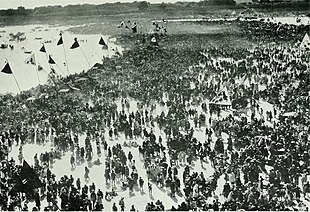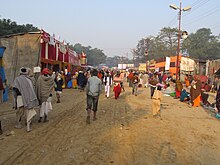| Gangasagar Mela | |
|---|---|
 | |
| Status | active |
| Genre | Fair, Religious gathering |
| Frequency | Every years |
| Venue | Confluence of the Ganges and the Bay of Bengal |
| Location(s) | Gangasagar, West Bengal |
| Coordinates | 21°38′12″N 88°03′19″E / 21.6367562°N 88.0554125°E / 21.6367562; 88.0554125 |
| Country | India |
| Previous event | 2025 |
| Next event | 2026 |
| Participants | Pilgrims |
| Sponsor | Government of West Bengal |
| Website | gangasagar |
Gangasagar Mela (Bengali: গঙ্গাসাগর মেলা) is a mela and festival in Hinduism, held every year at Gangasagar, West Bengal, India. The confluence of the Ganges and the Bay of Bengal is called the Gangasagar, the fair is held every year on Makar Sankranti at Kapilmuni's ashram located on the Gangasagar. The mela is celebrated on 14 or 15 January every year.
Gangasagar Mela is the second largest Hindu fair (after Kumbh Mela). Many people from different states of India come here every year to take a holy bath on Makar Sankranti day.
In 2024, Renowned Bengali Newspaper Aajkaal Quoted about 1 crore 10 lakhs devotees gathered in the mela.
History
Hindu scriptures
The Gangasagar is mentioned in the Mahabharata's Vana Parva, which provides proof of the existence of the pilgrimage site in 1500–2000 BC. According to the Mahabharata, the Pandavas traveled from the banks of the river Kaushik and reached the Gangesagarasangam, Confluence of Ganges and Sagara (Sea). According to Hinduism, the "Gangasagarasangam" mentioned in the Mahabharata is Gangasagar in Sagardwip, situated at the estuary of the Bhagirathi-Hooghly rivers – one of the two main branches of the Ganges– on the sea coast of West Bengal.
Legend has it that Kapilmuni, the progenitor of Samkhya philosophy, had an ashram at Gangasagara. Sixty thousand sons of Sagara King were consumed by Kapilmuni's wrath and their Ātmans (souls) were thrown into Naraka (hell). Bhagiratha, the grandson of the Sagara king, brought the Ganga from Svarga (heaven) to wash the remains of the Sagara's sons and free their Ātmans (souls).
Ancient times
The Gangasagar pilgrimage is also mentioned in Raghuvaṃśa, a Sanskrit epic poem written by the great poet Kalidasa in the fifth century AD. There is disagreement over the exact age of Kapil Muni's ashram. The temple of Kapil Muni is mentioned in the 16th century ancient Puthi Tirthaattvapradayini (Bengali: তীর্থতত্ত্বপ্রদায়িনী). An article about the Gangasagar Mela was printed on February 4, 1837, in the once popular Bengali newspaper Harkara (Bengali: হরকরা). It is written, "The one temple in this place (Sagar Dwip) has been known to people for 1400 years. In this temple there is established a Siddhapurusha named Kapil Muni.
Also, King Devapala of the Pala dynasty mentions in an inscription that he performed rituals at the confluence of the Gangasagar.
Middle Ages
During medieval times, pilgrims from every corner of the subcontinent defied many obstacles and dangers to reach Gangasagar on Makar Sankranti. During the perilous journey, the pilgrims faced diseases like cholera and small pox. Due to the danger and death faced by the pilgrims the phrase originated — saba tīrtha bāra bāra, gaṅgāsāgara ēkabāra.
Modern era

Kapalkundala, a Bengali novel written by Bankim Chandra Chattopadhyay, depicts a perilous journey to reach the Gangasagar. In 1914 AD, a man named Wilson mentions the temple of Kapilmuni in the District Gazetteer. According to the person's writings, Kapilmuni's temple was temporary structure surrounded by a bamboo fence. In front of the temple was a huge banyan tree, under which were murtis (idols) of Rama and Hanuman. Gangasagar Mela is mentioned in the Bhāratēra Tīrthayātrā (in en: India's Pilgrimage) by Shri Madhavachandra Varman published in 1336 Baṅgābda. This text mentions "three days of bathing in the Gangasagar during Makara Sankranti in Poush or Magh month, the fair lasts for five days".

After India's independence, the pilgrimage site began to flourish. Pictures of the temple were published in the Bengali book Gangasagar Mela O Pracina Aitihya by Tarundev Bhattacharya. According to the text, the permanent temple emerged in the form of a mature temple between 1964 and 1974. The Government of West Bengal assisted in the construction of a permanent temple in the 1970s. In the following decades, the number of pilgrims to the fair increased. At present, millions of people congregate every year on the auspicious day of Makara Sankranti or Poush-Sankranti (mid-January) in the month of Poush to celebrate the Gangasagar fair and the pilgrimage site.
Pilgrims
In 2007, about 300,000 pilgrims took the holy dip where the Ganges (Hooghly) meets the Bay of Bengal on the occasion of Makar Sankranti. Almost five-hundred thousand pilgrims thronged Gangasagar in 2008. For the rest of the year about 500,000 people come to the island. According to reports on 14 January 2018, 1.8-2 million people had visited Gangasagar in 2018, against 1.5 million in 2017. In 2023, about 51 lakhs pilgrims gathered in the Gangasagar Mela.
Dates, location and preparation

Dates
The Gangasagar Mela is organized on the occasion of the holy dip on Makar Sankranti, usually on January 14 or 15. Makar Sankranti is set by the solar cycle and corresponds to the exact time astronomical event of the Sun entering Capricorn and is observed on a day that usually falls on 14 January of the Gregorian calendar, but on 15 January in leap years. Makar Sankranti's date and time is analogous to Sidereal time of Zodiac sign of Capricorn (when sun enters).
In 2023, holy dip started on January 14, 6:30 PM and ended on January 15, 6:53 PM.
Location
Gangasagar Mela is held at Gangasagar, Sagar Dwip. The place belongs to South 24 Parganas district, West Bengal. The Mela is organized around Kapil Muni's ashram. The site of the Mela is on the banks of the confluence of the Ganges and the Bay of Bengal.
Preparation for the fair

Pilgrims from different states of India arrive on the occasion of Ganga bath and the Gangasagar Mela. Most of the pilgrims first arrive at Kolkata to visit Gangasagar. Transit camps are established in Kolkata every year for the convenience of pilgrims. All kinds of civic facilities are provided to these camps.

The biggest obstacle to reaching Sagar Dwip is the Muri Ganga River; Pilgrims have to cross this river on their journey. However, due to the low navigability of the river, it is not possible to cross the river without tide. Every year, dredging is carried out in the river for uninterrupted ferry operation. Ferry services are operated between Kakdwip and Kachuberia, Sagar Dwip on the occasion of fairs and Ganga bath. Several temporary jetties were constructed for faster and more pilgrim transport. All vessels and buses can be monitored from a central control room. GPS and NAVIC (Navigation with Indian Constellation) technology is used in all the transport vehicles of Sagar Dwip for surveillance. Vessels are also provided with navigation lights to prevent visibility problems due to fog.
Rituals

On the day of Ganga Bathing, Hindu devotees gather early in the morning and take a holy dip in the Ganges River. They offer offerings to Lord Surya and chant Lord Surya Mantra.
After completing the rituals, people worship Kapil Muni and light a pradeep (Diya) with desi ghee. Some also perform Yajna and Homa on the day of Ganga bathing. Some devotees even observe a strict fast on Gangasana days. On this auspicious day of Ganga bathing, devotees express their gratitude to Goddess Ganga and seek forgiveness for their misdeeds knowingly or unknowingly.
Special Certificate
The District Administration of South 24 Parganas handed over special certificates to all the pilgrims who came to Gangasagar Mela. Apart from the photo and phone number of the pilgrims, the certificates also contain a greeting message from the state government.
References
- "Centre doesn't spend a single penny on Gangasagar Mela, claims Mamata Banerjee". www.hindustantimes.com. Archived from the original on 30 March 2023. Retrieved 30 March 2023.
- ^ "Ganga Sagar Mela". holidify. Archived from the original on 1 April 2023. Retrieved 29 March 2023.
- ^ Ivermee 2021, pp. 194–195.
- ^ "Gangasagar Mela: গঙ্গাসাগর থেকে ফেরার পথে মুড়ি গঙ্গার উপরে আটকে গেল ভেসেল".
- ^ "আজ গঙ্গাসাগরে পুণ্যস্নান, সন্ধ্যার মকরস্নানে কি সর্বকালের রেকর্ড ভাঙবে?". bangla.hindustantimes.com (in Bengali). Kolkata. 14 January 2023. Archived from the original on 29 March 2023. Retrieved 29 March 2023.
- Basu 1954, p. 190.
- Ghosh 2020, p. 203.
- Basu 1954, pp. 186–187.
- Ghosh 2020, pp. 203–204.
- ^ "আশ্রমকে কেন্দ্র করেই পূণ্যস্নান! জানুন কপিল মুনির কাহিনী". bangla.aajtak.in (in Bengali). Archived from the original on 29 March 2023. Retrieved 29 March 2023.
- ^ "Past Gangasagar Mela". www.gangasagar.in. Retrieved 18 January 2024.
- ^ "গঙ্গাসাগরের সাজঘরে". www.anandabazar.com (in Bengali). Gangasagar: ABP. 12 January 2020. Retrieved 18 January 2024.
- "Dip, deaths mark Sagar mela finale". The Statesman. 16 January 2008. Archived from the original on 24 May 2013. Retrieved 30 March 2023.
- Chattopdhyay, Debashis (15 January 2007). "Bridge plea for Sagar tourism". The Telegraph. Calcutta, India. Archived from the original on 28 January 2007.
- "West Bengal: On Makar Sankranti 2018, Ganga Sagar Mela witnesses record crowds". Home>>India. DNA, 14 January 2018. 14 January 2018. Archived from the original on 30 March 2023. Retrieved 30 March 2023.
- "Gangasagar Mela: Devotees, seers take holy dip in Ganges on Makar Sankranti". www.business-standard.com. Archived from the original on 30 March 2023. Retrieved 30 March 2023.
- ^ Ivermee 2021, p. 194.
- "sun enters Capricorn zodiac". Archived from the original on 28 October 2021. Retrieved 29 March 2023.
- "গঙ্গাসাগর মেলার উদ্বোধন". Anandabazar. Kolkata. Archived from the original on 29 March 2023. Retrieved 29 March 2023.
- ^ "কপিল মুনির আশ্রমকে ঘিরেই গঙ্গাসাগরের মহামিলন মেলা, কী মাহাত্ম্য তাঁর?". www.sangbadpratidin.in (in Bengali). Archived from the original on 30 March 2023. Retrieved 30 March 2023.
- ^ "গঙ্গাসাগর মেলার প্রস্তুতি শুরু". www.anandabazar.com (in Bengali). Gangasagar: ABP. 1 December 2023. Retrieved 18 January 2024.
- "ইসরো-র 'নেভিক' প্রযুক্তিতে নজরদারি গঙ্গাসাগর মেলায়". www.anandabazar.com (in Bengali). Gangasagar: ABP. 30 December 2023. Retrieved 18 January 2024.
- ^ "Gangasagar Mela 2023: Date, Place, Story, Rituals and Significance". timesofindia.indiatimes.com. 8 January 2023. Archived from the original on 30 March 2023. Retrieved 30 March 2023.
- ^ "গঙ্গাসাগরে এলেই মিলবে সচিত্র শংসাপত্র, পুণ্যার্থীদের জন্য বিশেষ উদ্যোগ রাজ্য সরকারের". Anandabazar (in Bengali). Kolkata. 24 December 2022. Archived from the original on 29 March 2023. Retrieved 29 March 2023.
Bibliography
- Basu, Rajshekhar (1954). মহাভারত (in Bengali). Kolkata: MCR Sarkar & Sons. ISBN 81-7157-006-2.
- Ghosh, Binoy (January 2020). পশ্চিমবঙ্গের সংস্কৃতি (in Bengali). Vol. 3rd. Kolkata: Deep Publishing. ISBN 978-93-89584-39-4.
- Ivermee, Robert (2021). Hooghly: The Global History of a River (1st ed.). Noida, Uttar Pradesh, India: HarperCollins. ISBN 978-93-5422-314-3.